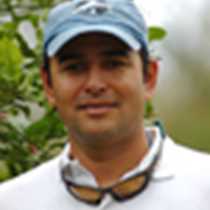Santa Cruz Island
We arrived this morning to Academy Bay, Santa Cruz Island. This is the second largest island in the Galápagos and has the largest human population; here we also find the headquarters of the Charles Darwin Research Center and the National Park Service. The morning was dedicated to visiting the rearing center and learning about the restoration programs for Galápagos giant tortoises and land iguanas.
We had an opportunity to see the different varieties of giant tortoises and observe their diverse shell shapes. There are three main types: dome shape, saddleback and the “intermediate” variety. Fortunately we found each of the different types as we walked along the wooden boardwalk at the Darwin Station. This area also offers a great variety of plant life unique to the region, and gave us the chance to observe many species of birds and their nests. Particularly abundant were the famous Darwin finches. After our visit to the tortoise corrals and the rearing center, we headed down the main street of Puerto Ayora, fully exploring this charming little town and its shops.
We took buses to a farm in the highlands, walked a ¼ mile through a lava tube and then ate a well deserved buffet lunch. Afterwards we began our exploration of this lush habitat and went driving even further into the forest and fields in search of the giant tortoise in wild. Indeed we found many of these famous reptiles, some feeding, others not doing much. We were all very happy to find them and imagined ourselves as the first explorers coming upon these giant and ancient creatures.
Later in the afternoon we arrived at the exuberant and evergreen Scalesia (giant daisy) zone. Here we observed the intricate botanic ecosystem where there are many species of ferns, lichens, mosses and epiphytes covering the shrubs and trees. We identified more of the Darwin finches and spotted a few orchids. We gazed into the deeply collapsed depressions, geological formations known as “the Pit Craters” or Los Gemelos. We left the Scalesia forest behind and returned to Puerto Ayora as the afternoon light began to fade. We were all happy to have filled another day with new and interesting experiences!
We arrived this morning to Academy Bay, Santa Cruz Island. This is the second largest island in the Galápagos and has the largest human population; here we also find the headquarters of the Charles Darwin Research Center and the National Park Service. The morning was dedicated to visiting the rearing center and learning about the restoration programs for Galápagos giant tortoises and land iguanas.
We had an opportunity to see the different varieties of giant tortoises and observe their diverse shell shapes. There are three main types: dome shape, saddleback and the “intermediate” variety. Fortunately we found each of the different types as we walked along the wooden boardwalk at the Darwin Station. This area also offers a great variety of plant life unique to the region, and gave us the chance to observe many species of birds and their nests. Particularly abundant were the famous Darwin finches. After our visit to the tortoise corrals and the rearing center, we headed down the main street of Puerto Ayora, fully exploring this charming little town and its shops.
We took buses to a farm in the highlands, walked a ¼ mile through a lava tube and then ate a well deserved buffet lunch. Afterwards we began our exploration of this lush habitat and went driving even further into the forest and fields in search of the giant tortoise in wild. Indeed we found many of these famous reptiles, some feeding, others not doing much. We were all very happy to find them and imagined ourselves as the first explorers coming upon these giant and ancient creatures.
Later in the afternoon we arrived at the exuberant and evergreen Scalesia (giant daisy) zone. Here we observed the intricate botanic ecosystem where there are many species of ferns, lichens, mosses and epiphytes covering the shrubs and trees. We identified more of the Darwin finches and spotted a few orchids. We gazed into the deeply collapsed depressions, geological formations known as “the Pit Craters” or Los Gemelos. We left the Scalesia forest behind and returned to Puerto Ayora as the afternoon light began to fade. We were all happy to have filled another day with new and interesting experiences!




